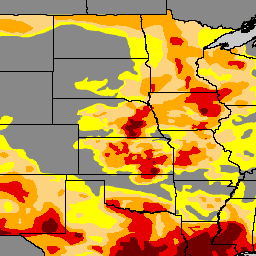
- Proprietário do catálogo
- Catálogo da comunidade do GEE
- Disponibilidade de conjuntos de dados
- 2000-01-04T00:00:00Z–2025-11-18T00:00:00Z
- Provedor de conjunto de dados
- National Drought Mitigation Center
- Tags
Descrição
O U.S. Drought Monitor é um mapa divulgado todas as quintas-feiras que mostra as partes dos EUA que estão em seca. O mapa usa cinco classificações: anormalmente seco (D0), mostrando áreas que podem estar entrando ou saindo de uma seca, e quatro níveis de seca: moderada (D1), grave (D2), extrema (D3) e excepcional (D4). O Monitor de Seca é um esforço em equipe desde sua criação em 1999, produzido em conjunto pelo National Drought Mitigation Center (NDMC) da Universidade de Nebraska-Lincoln, pela National Oceanic and Atmospheric Administration (NOAA) e pelo Departamento de Agricultura dos EUA (USDA). O NDMC hospeda o site do monitor de seca e os dados associados, além de fornecer o mapa e os dados para a NOAA, o USDA e outras agências. Ele está disponível sem custo financeiro em droughtmonitor.unl.edu.
Bandas
Tamanho do pixel
250 metros
Bandas
| Nome | Mín. | Máx. | Tamanho do pixel | Descrição |
|---|---|---|---|---|
DM |
0 | 4 | metros | Classes de seca |
Termos de Uso
Termos de Uso
O trabalho está licenciado sob uma licença de dados abertos para uso. O U.S. Drought Monitor é produzido em conjunto pelo National Drought Mitigation Center da Universidade de Nebraska-Lincoln, pelo Departamento de Agricultura dos Estados Unidos e pela Administração Oceânica e Atmosférica Nacional. Mapa cortesia da NDMC.
Citações
National Drought Mitigation Center; U.S. Department of Agriculture; National Oceanic and Atmospheric Administration (2023). United States Drought Monitor. Universidade de Nebraska-Lincoln. https://droughtmonitor.unl.edu/. Acessado em 17/09/2023
Descobrir com o Earth Engine
Editor de código (JavaScript)
var usdm = ee.ImageCollection( "projects/sat-io/open-datasets/us-drought-monitor" ); /* Category Description DO Abnormally Dry D1 Moderate Drought D2 Severe Drought D3 Extreme Drought D4 Exceptional Drought */ var usdm = ee.Image(usdm.toList(usdm.size()).get(-1)); // Define a dictionary which will be used to make legend and visualize image on map var dict = { names: [ "DO Abnormally Dry", //1 "D1 Moderate Drought", //2 "D2 Severe Drought", //3 "D3 Extreme Drought", //4 "D4 Exceptional Drought", //5 ], colors: ["FFFF00", "FCD37F", "FFAA00", "E60000", "730000"], }; // Create a panel to hold the legend widget var legend = ui.Panel({ style: { position: "bottom-left", padding: "8px 15px", }, }); // Function to generate the legend function addCategoricalLegend(panel, dict, title) { // Create and add the legend title. var legendTitle = ui.Label({ value: title, style: { fontWeight: "bold", fontSize: "18px", margin: "0 0 4px 0", padding: "0", }, }); panel.add(legendTitle); var loading = ui.Label("Loading legend...", { margin: "2px 0 4px 0" }); panel.add(loading); // Creates and styles 1 row of the legend. var makeRow = function (color, name) { // Create the label that is actually the colored box. var colorBox = ui.Label({ style: { backgroundColor: color, // Use padding to give the box height and width. padding: "8px", margin: "0 0 4px 0", }, }); // Create the label filled with the description text. var description = ui.Label({ value: name, style: { margin: "0 0 4px 6px" }, }); return ui.Panel({ widgets: [colorBox, description], layout: ui.Panel.Layout.Flow("horizontal"), }); }; // Get the list of palette colors and class names from the image. var palette = dict["colors"]; var names = dict["names"]; loading.style().set("shown", false); for (var i = 0; i < names.length; i++) { panel.add(makeRow(palette[i], names[i])); } Map.add(panel); } /* // Display map and legend /////////////////////////////////////////////////////////////////////////////// */ // Add the legend to the map addCategoricalLegend(legend, dict, "US Drought Monitor"); // Add USDM Image image to the map Map.addLayer( usdm, { min: 0, max: 4, palette: dict["colors"] }, usdm.get("system:index").getInfo() );

